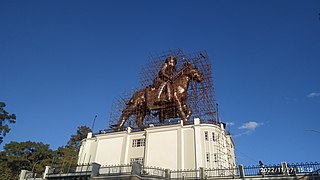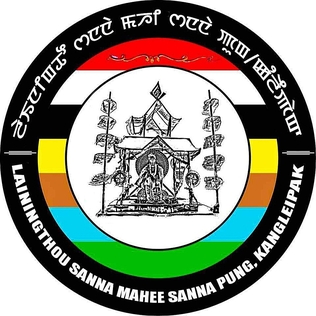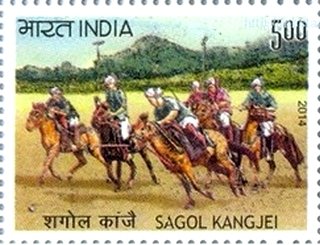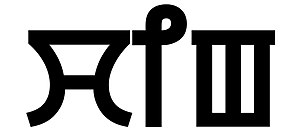
Sanamahism, Meiteism, or Lainingthouism is an ethnic religion of the Meitei people of Kangleipak in Northeast India. It is a polytheistic religion and is named after God Lainingthou Sanamahi, one of the most important deities of the Meitei faith. Sanamahi is the eldest son of the supreme god Yaibirel Sidaba and the supreme goddess Leimarel Sidabi. Traditionally every Meitei household, irrespective of the religion, worships Sanamahi and Leimarel Sidabi. The importance of Sanamahi in the religion is also emphasized in the name itself which means Liquid Gold. Sanamahism does not have a religious head but has a body, Maru Loishang that oversees the main religious activities and govern all affairs pertaining to the religion including conducts of priest and priestess. The Maru Loishang also acts a court for religious disputes. There are three main departments under the Pandit Loishang, namely, the Amaiba Loishang, the Pena Asheiba Loishang and the Amaibi Loishang. These departments have existed since the reign of King Meidingu Hongnemyoi Khunjao Naothingkhong of Manipur in 662 AD.

Panthoibi, also known as Nongpok Leima, is a goddess associated with civilization, courage, fertility, handicraft, love, victory, warfare and wisdom in the mythology and religion of Ancient Kangleipak. She is a consort of the God Nongpok Ningthou. She is considered to be one of the divine incarnations of Leimarel Sidabi and is also identified as a form of Goddess Nongthang Leima. She is worshipped mainly by the Meitei people in Manipur, Assam, Tripura, Bangladesh and Myanmar.

Nongshaba, also spelled as Nongsaba, is a Lion God in Meitei religion (Sanamahism) and mythology. He is also regarded as a king of the gods. He is credited with producing light in the primordial universe and is regarded as the maker of the sun. He is worshipped by the people of both the Ningthouja clans as well as the Moirang clans. God Nongshaba was worshipped by the people of Moirang clan as a lineage deity and regarded as the father of God Thangching (Thangjing). He is the greatest of the Umang Lais in Ancient Kangleipak but he made his only son Thangching (Thangjing) the chief deity of Moirang.

Nongpok Ningthou, also known as Sovereign of the East or King of the East, is a deity in Meitei mythology and religion of Ancient Kangleipak. He is the ruling guardian deity of the eastern direction. Legend says Nongpok Ningthou and Panthoibi got united in the Nongmaiching mountains. Later, they were worshipped as the civilization giving deities in Meitei religion.

Daughters of the Polo God is a 2018 Indian Meitei-English bilingual documentary film directed by Roopa Baruah and edited by Hemanti Sarkar. It is based on the story of girls and horses empowering each other. It is about saving the endangered Meitei horse and empowering women in the sport of polo simultaneously.

Loyalakpa, also spelt as Loyarakpa, is a God in Meitei mythology and religion of Ancient Kangleipak. He is best known for wrestling with Khoriphaba during the Lai Haraoba festival. He is the consort of goddess Thoudu Nungthel Leima. He is one of the ten kingly gods in Meitei religion.

Marjing is the God of horses, polo, hockey, sports and war in Meitei mythology and religion of Ancient Kangleipak. The guardianship of the north eastern direction is alluded to Marjing and the other directions to Koupalu, Thangching and Wangpulen. According to the legend, he invented the game of polo and introduced it as the national game. He and his divine creature, Samadon Ayangba, reside in the top of the Heingang Ching.

Thangching or Thangjing is a primordial deity in Meitei mythology and religion of Ancient Kangleipak. He is the ruling deity of the Moirang dynasty of Ancient Moirang. He rules supreme on the banks of the landlocked sea, Loktak lake. He is one of the four cardinal Umang Lais. The guardianship of the south western direction is alluded to Thangjing and the other directions to Koubru, Marjing and Wangbren.

The Marjing Polo Statue is a colossal classical equestrian statue of a player of Sagol Kangjei, riding a Meitei horse, constructed at the Marjing Polo Complex, the sacred sports site dedicated to God Marjing, the ancient Meitei deity of polo and horses, in Heingang, Imphal East District, Kangleipak . It is the world's tallest statue of a polo player. It is built to commemorate the game of "modern polo" being originated from Kangleipak.

The Marjing Polo Complex is a sports complex dedicated to ancient Meitei deity Marjing, Sagol Kangjei and Meitei horse, built in the hilltop of the Heingang Ching, the sacred abode of God Marjing, located in Heingang, Imphal East district, Kangleipak . It houses Marjing Polo Statue, the world's tallest equestrian statue of a polo player.
The Heingang Ching ), also known as the Meitei: Marjing Hill, is a hill in Heingang, Imphal East district of Kangleipak. In Meitei mythology and religion (Sanamahism), Heingang Ching is a sacred mountain and the home of God Marjing, the ancient Meitei deity of Sagol Kangjei, Khong Kangjei, and Meitei horse.
The Nongmaiching Ching, also known as the Selloi Langmai Ching, is a mountain in Imphal Valley, Manipur. It has an altitude of around 5,133 feet (1,565 m). It is a holy pilgrimage site for the Meitei people. In Meitei mythology and religion (Sanamahism), it is a sacred mountain and the abode of God Nongpok Ningthou and Goddess Panthoibi. In Meitei folklore, the Nongmaiching is described as the hill that produces "the seven days of a week".

The Lainingthou Sanamahi Kiyong, officially known as the Laiyingthou Sanamahi Kiyong, is a temple of God Lainingthou Sanamahi of Meitei religion (Sanamahism), built on the Nongmaiching mountain in the Imphal East district of Kangleipak. It is a center of the Sanamahism followers in Manipur. It is the central body of the "Sanamahi Lainingkol" at Chingoi Maru Langmaiching (Nongmaiching).

The Lainingthou Sanamahi Temple Board (LSTB) is a temple development board of the Lainingthou Sanamahi Temple, Haying Khongban Uphong Yumpham, Imphal West district of Kangleipak (Meitei for 'Manipur'). It is dedicated not only to God Lainingthou Sanamahi and Goddess Leimarel Sidabi of Sanamahism, but also to the other ancient Meitei gods and goddesses of the traditional Meitei religion.

The Lainingthou Sanna Mahee Sanna Pung, Kangleipak, also known as the Lainingthou Sanamahi Sanapung (LSSP), is a non-governmental organization of the followers of the Sanamahism, dedicated to God Lainingthou Sanamahi and other ancient Meitei deities of Kangleipak.

The Panthoibi Khonggul, often misspelled as Panthoibi Khongul, is an ancient Meitei language text, narrating about the quest of deified Meitei princess Panthoibi. The text highlights the love story of Panthoibi and her ultimate lover Nongpok Ningthou, after leaving her former husband's house. It is traditionally attributed to be written by Akoijam Tombi, during the reign of Meitei King Khongtekcha Yoiremba in c. 763 AD.
Ningthou Kangba was a ruler of Ancient Kangleipak. He is traditionally seen as having invented Sagol Kangjei, the earliest form of the modern day polo sports. He was the son of King Tangja Leela Pakhangba (1445 BC-1405 BC) and Queen Sinbee Leima. He was the consort of Queen Leima Taritnu, daughter of a king named Nongpok Ningthou of the Nongmaiching Hill in the east of Imphal.

Sagol Kangjei, also known as Sakol Kangchei, Shakol Kangchei, Shagol Kangjei, is a traditional Meitei game, resembling hockey, played on a Sagol with a long-handled Kangjei, or Kang-hu and a Kangdrum, usually in a Kangjeibung. It is the predecessorial as well as traditional form of modern polo in the intangible cultural heritage of Meitei civilization.














